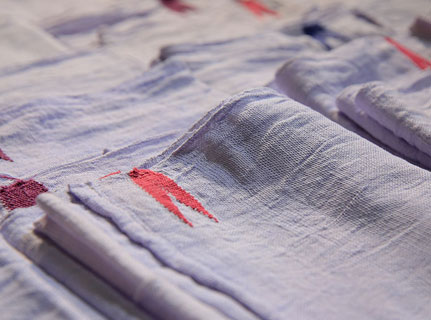Why Thorth?

The climate has changed for the worse, and this change ranges from shifting weather patterns on the one hand, that threaten agriculture, to rising water levels on the other, leading to catastrophic floods across the world. The change in climate is well reflected in the bizarre phenomena we have been witnessing recently all over the globe, like the Australian bush fire, the California wildfire, a multi-year drought in South Africa and China, severe floods in Japan and India, to name a few. Today the impacts of climate change are global in scope and unprecedented in scale. If not checked effectively at this point, this adverse climate will lead us to the Doomsday very soon.
The world is moving fast into a global water crisis. Many cities today face zero groundwater situations. At this critical juncture, we pride ourselves in being a proactive crusader of one of the fastest and most easily implementable solutions that can take us a long way in reducing global water consumption and demand. We are a pioneer in propagating the amazing paybacks of the handwoven indigenous bath towel of Kerala, ‘Thorth’.
‘Thorth’ is the traditional bath towel of Kerala, India. The word Thorth is derived from the language of the state of Kerala, namely Malayalam. ‘Thorth’ literally means ‘something that removes moisture’. ‘Thorth’ is probably one of the lightest of all bath towels with immense absorptive capacity. This unique property gives Thorth the power to play a revolutionary role in the forthcoming days of water scarcity.
Water & Climate Change
Water scarcity will be a global reality within two decades. Clean water is becoming an increasingly scarce commodity. The global demand for water has been increasing at a rate of about 1% per year over the past decades as a result of population growth, economic development and changing consumption patterns, among other factors, and it will continue to grow significantly in the foreseeable future.Water scarcity will be a global reality within two decades. Clean water is becoming an increasingly scarce commodity. The global demand for water has been increasing at a rate of about 1% per year over the past decades as a result of population growth, economic development and changing consumption patterns, among other factors, and it will continue to grow significantly in the foreseeable future.Water scarcity will be a global reality within two decades. Clean water is becoming an increasingly scarce commodity. The global demand for water has been increasing at a rate of about 1% per year over the past decades as a result of population growth, economic development and changing consumption patterns, among other factors, and it will continue to grow significantly in the foreseeable future.Water scarcity will be a global reality within two decades. Clean water is becoming an increasingly scarce commodity. The global demand for water has been increasing at a rate of about 1% per year over the past decades as a result of population growth, economic development and changing consumption patterns, among other factors, and it will continue to grow significantly in the foreseeable future.
Water Usage & Availability

- Industrial and domestic demand for water will increase much faster than agricultural demand, although agriculture will remain the largest user overall
- Water use has been increasing worldwide by about 1% per year since the 1980s, and is expected to continue increasing worldwide until 2050, amounting to 20 to 30% increase in the total water consumption
- The vast majority of the growth in demand for water will occur in countries with developing or emerging economies
- The global water cycle is intensifying due to climate change, with wetter regions generally becoming wetter and drier regions becoming even drier
- As per the reports of NITI Ayog, 21 Indian cities including Delhi, Bengaluru, Chennai and Hyderabad will run out of groundwater by 2020
Popular Methods to Increase Water Availability
There are several ways to enhance water availability (e.g., soil moisture retention, groundwater recharge), improve water quality (e.g., natural and constructed wetlands, riparian buffer strips), and reduce risks associated with water‐related disasters and climate change (e.g., floodplain restoration, green roofs). We also have more advanced methods like the desalination of seawater, waterless technologies, zero liquid discharge, water from fog catching, etc. but in spite of having numerous methods to combat water scarcity, our planet is getting more and more water-stressed. A possible reason for this could be that the implementation of the above-said methods is difficult and capital-intensive.
Can Thorth be a Major Solution?

Among all the sectors responsible for maximum water consumption, the first and foremost is the agriculture industry, which accounts for about 70% of global freshwater withdrawals.
Studies have suggested that the water usage in hotels averages between 100 gallons per day (gpd) per room to 400 gpd per room. The age, size, class of hotel, type of cooling, on-site laundry, irrigation needs, swimming pools, and the existence of full service restaurants – all have a significant effect on total water use. This averages out to about 36,500 to 73,000 gallons of water per room per year. World Resources Institute foresees a future that will be water stressed, and warns that 33 countries will face extremely high water stress in 2040.
Resource Depletion

Resource depletion is a major issue that the whole world is facing today and for which several popular and well known eco-friendly practices have been adopted, like the use of energy-efficient light bulbs, towel reuse, waste/greywater treatment, and water conservation. As part of environmentally responsible behaviours of hotels and hotel guests, it is very important to reduce water consumption. Implementing Project Thorth in hotels can help drastically reduce consumption of water, electricity and soap, reduce labour, transportation costs, and sewage costs. By introducing Thorth, hotels can inspire guests to adopt conservation behaviours and thereby reduce the average, actual costs incurred per occupied guestroom. This eco-friendly behaviour by hotel guests will undoubtedly reduce the environmental impact of the hotel industry, and contribute to a cleaner environment.
Minimal Water required for washing
We focus on hotels in the first phase of campaign. Hotels use various kinds of towels which can be easily replaced with Thorth and other alternative products made with Thorth. Secondly, most people staying in hotels travel more and they are ready to accept new ideas and suggestions, like Thorth.
Saving in transportationSince the weight and volume of Thorth is much less, compared to a conventional towel, the number of Thorth transported per load will be many more compared to the number of towels. This will ultimately help in reducing the trips required for transporting Thorth to destinations, and thereby save fuel for transportation and ultimately lead to a reduction in carbon footprint.
Thorth can help in cost-cuttingSwitching over to Thorth reduces expenses by at least two-thirds, even if two Thorths are used instead of a single bath towel. The average price of a Thorth (140 cm x 70 cm) is Rs 100/- (US $1.5) whereas the average price of a bath towel (140 cm x 70 cm) is Rs 490/- (US $7).
Life expectancyIn the normal course, a Thorth will last for one year but a bath towel can be used by the hospitality industry for two years.
Drying TimeThe drying time for the bath towel is much more compared to Thorth. This warrants a greater number of bath towels in place of Thorths.
Free Take Away From HotelsThorth can be included in the free take away list in hotels. Used bath towels can be carriers of contagious diseases, especially if there is any flaw in the laundry and drying systems. In hotels, Thorth, like other toiletries, can be kept for one time use. (It must be noted that bath towels cannot be given away like that due to their high price.) Thorth will make an ideal parting gift to the clients, on which the hotel brand can be imprinted and this can also act as a marketing tool for the hotels. Besides, guests would love to take it back home, especially if they are given a proper note on the environmental impacts it can bring about.
Thorth Vs Towel (Comparison of Physical aspects)Sl.No. |
Physical Aspects |
Bath Towel |
Thorth |
1 |
Size |
140 cm X 70cm |
140 cm X 70cm |
2 |
Weight |
600 gms |
110 gms |
3 |
Cotton required for production |
600 gms |
110 gms |
4 |
Water for soaking |
3 L |
0.6 L |
5 |
Water for washing |
12 L |
2.5 L |
6 |
Time for drying (Normal sunlight or wind) |
10-12 Hrs |
1-2 Hrs |
1. |
Hotel Wash Cloth |
Wash cloth in hotel rooms is a must have. Hotel wash cloth comes in various sizes. You can choose from 12" x 12" and 13" x 13" wash cloths. Hotel wash cloth comes in White colour |
2. |
Hand Towel |
Hand towels are useful in Hotel Room, Spa Area, and Gym Area and even in Cooking & Dining areas of a hotel. |
3 |
Face Towel |
Towel that is smaller than a bath towel is often of smooth-surfaced material and is used especially for drying the face |
5 |
Bath Sheet |
Bath sheet is a bigger version of bath towel. Bath sheets are usually 35” X 60” which means more absorbency and more to wrap around you |
6 |
Bath Mat |
Bath mats in the hotel bathrooms are meant mainly to keep the bathroom clean |
7 |
Bath Towel |
Large towel suitable for drying oneself after bathing or showering |
8 |
Pool Towel |
Pool towels are oversized towels designed for use by the pool or lake |
9 |
Bath Robe |
Robes are offered to guests at beds and breakfasts, spas and resorts |
10 |
Spa Linen |
Spa Linen, a bedding system, which is specifically designed for the spa treatment table |
Water Saving by Thorth
The estimated number of hotels in India alone is around 1.8 million, with 50 million rooms. Assuming that the rooms are twin bed, and 200 room nights are sold out in a year; a total of around 10 billion rooms will be sold a year, in India alone.
There can be saving, in the following areas : (Estimates only)
Support to handloom weavers
Handloom weavers are one of the lowest paid categories of artisans, even though they dedicate their lives for a green living. Promoting Thorth will ultimately benefit the handloom industry.